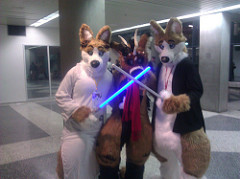#Furries #Therians #Pets and #Pups
My #FetishFriday segments touch upon furries and pony play but I wanted to dive a little deeper into the topic of furries, therians, pets, and pups as well as pony play in order to reach out to a large group of folks that might be seeking out sex therapy services but don’t know where to find an affirming and furry-friendy and pet-aware therapist.
For those of you who don’t know what all this means, that’s okay! I ask that you read this blog with an open mind AND to be open to perhaps one of these topics is exactly what you might be missing in your own sex and fantasy life (and that many of these personas/identities have little to nothing to do with sex).
For those of you who DO know what this all means, I am hoping by writing this blog, you’ll have more hope on finding an affirming and knowledgeable therapist who won’t pathologize or judge your play/identity. If you are located in the states of Maine, Massachusetts, New Hampshire, New York, or Texas, I can work with you online or in person in Austin, TX. If you live beyond those states, I would recommend checking out www.aasect.org to help you find an affirming therapist to work with- after all, furries have therapy needs too right?
A lot of the information I am presenting in this blog come from my own clinical experience and training as well as drawn from the presentation “Furries and Pets and Therians, Oh my! Exploring Humanimal Intersubjectivities” presented by Carly Goodkin at the 2018 AASECT Conference.

So let’s get going! Let’s start with some definitions so we know what we are talking about here (and if it isn’t clear with what we are talking about, feel free to do some of your own research on what it is that we are talking about!):
Furries: someone with an interest in anthropomorphic animals.
Anthropomorphism: the attribution of human characteristics or behavior to a god, animal, or object.
Fursonas: an avatar or alter ego that someone role-plays or identifies as when interacting with other members of the community of furries, also known as the Furry Fandom
Furries is not zoophilia or beastiality. The majority of furries do not cite sexual gratification as their main motivator (International Anthropomorphic Research Project, 2016)
Pet Play: form of role-play in which one of the multiple participants adopt the role of domesticated, wild, livestock, or mythical animal. What one might do as a pet:
- Eating
- Resting
- Training
- The pet may exhibit traditionally animalistic characteristics, such as extensive non-verbal communication featuring animal noises, biting, and nuzzling
- Pets may interact with each other at conventions
Often associated with the kink community and power exchange. There might be packs associated with pets, that might have a hierarchy. There is a lot of gear and the gear/toys generally fall into two categories (gear that help you channel that animal identity- tails, ears, clothes or gear that you would have to play with a pet- leashes, bowls, pet toys). Pet play can be a scene pet (playing as a pet only in a scene) or a lifestyle pet (playing as a pet as a greater identity in their own lifestyle- home, public, school, work?).
Human Pets: Some individuals engage in human-pet play, a form of role-play in which an individual is treated as a pet without taking on animal characteristics. Below is a great online petplay class by a youtuber that will walk you through her experience of petplay and being a human pet.
Therian/Therianthrope: People who believe that they are, in whole or in part, a non-human animal and this is part of their core being spiritually or mentally
There is sometimes an Awakening: realizing and accepting that you are a therian and some therians identify as transpecies and draw parallels with transgender narratives. There can also be mental and/or physical shifting: perceived changes in one’ mental state or aura from human to animal.
Otherkin: People who identify, in whole, or in part, of something non-human:
– Divine
– Monsterkin
– Aviankin
– Godkin
– Spacekin
– Alienkin
– Angelkin
There is a great YouTube Channel: Therian Nation that can explain these concepts more in detail than I do here. Here is their intro video:
Working with Furries, Pets, Pups, and Therians in the Therapeutic Context
As an affirming therapist and aware and friendly of the furry, pet, pup, therian and kink communities, I want to make sure that my clients who identify in these populations at the very least feel comfortable with not only sharing with their therapist how they identify/play but also feel comfortable that their therapist will not judge or pathologize them for being a part of these communities.
Many furries report not feeling comfortable either going to therapy or sharing with their therapist they participate in this community because of fear of judgment and lack of understanding and the fear of being stereotyped into a category of people that only participates sexually in this identity. As mentioned before, most furries do not participate for the main reason of sexual gratification.
Why do People Participate/Identify as these Identities?
So why do people participate in these identities? A lot report that it feels more natural (therians) and that this is a fundamental part of their identity. Some share that it is a social and emotional outlet for them and that they built a strong community within the communities around participate (furries). Many enjoy the erotic, imaginative, and playful nature of the play (pups, pets, and ponies). Almost all report a change in their headspace.
Headspace: a basic mindset permission to go away from executive functioning and going primal.
“Great psychological and emotional release to be able to come home and let loos the restrictions of humanity and what humans are ‘supposed to be like'”. – Skylerpet
People often report that getting into their character or playing in these scenes allows them to let go of human stressors, expectations, anxieties and just be more primal and basic in their play.
Others report that this is the only time they find that allows them to explore their identity and sense of self.
Identity and self-exploration: People share that taking on animal forms allow them to express or explore an innate part of self, and gives them the opportunity to explore different characteristics culturally associated with animals (pups are playful, foxes are mischievous, mules are stubborn, bunnies are timid). This augments their inner strengths and allows them to create an identity that is an idealized version of self.
Gender and Sexual Orientation Exploration: It allows people to the opportunity to play with fantasy around gender and sexual orientation.
Provides expanded social experiences: People cite this as one of the main reasons for playing and exploring these areas. Playing/being in these spaces allow stronger nonverbal forms of interaction and broadened forms of physical affection. Movement beyond normative forms of social interaction to experience altered communication and physical contact could be enjoyable for people. Many are seeking novelty and often participants report having higher levels of skin hunger. These communities can easily accommodate and welcome those who have language barriers, who might typically struggle with socializing, and who are differently abled physically or mentally. Where people may have not felt that they belonged in other social experiences, these communities are very inclusive.
Community Inclusivity: These communities have an emphasis on acceptance and inclusivity, including people who are marginalized on basis of gender identity and sexual orientation and disability status.
Escape from Oppressive Structures: These spaces allow participants to escape from oppressive structures and experience a freedom from the ways they SHOULD be.
With a combination of headspace, inclusivity, and expanded ways of interacting can mean an escape from: capitalist/materialistic concerns and oppression, homophobia, transphobia, racism, body shaming, ableism, and other issues of the world… where else can someone get this?
Expanded BDSM Experiences: human-animal intersubjectivity may offer different experiences of subjugation, humiliation, or degradation; dependence or caregiving especially in a pet/owner dynamic.
Sex as a Motivator: For some people sexual gratification is a primary or partial motivator. This can be through watching content, in-person interactions, and online chatting or roleplaying. There is a common interest to meet partners who participate and are accepting of the lifestyle. But as I mentioned several times, most do not participate for sex or sexual interactions as a main, primary motivator.
A subset of furry pornography is called “Yiff” which is defined as furry content porn.
Yiffing: is the act of having sex when you are this furry mindset. Most people are not having sex in their fur suits: expensive, hard to clean, and really hot.
More Research on Anthropomorphism
International Anthropomorphic Research Project
Conventions
Hopefully, this piece has helped to explain these often misunderstood but very delightful sexual subcultures. If you are a furry, therian, pet, pup, pony and any way you are and are looking for a therapist, feel free to reach out at the number or email below.

